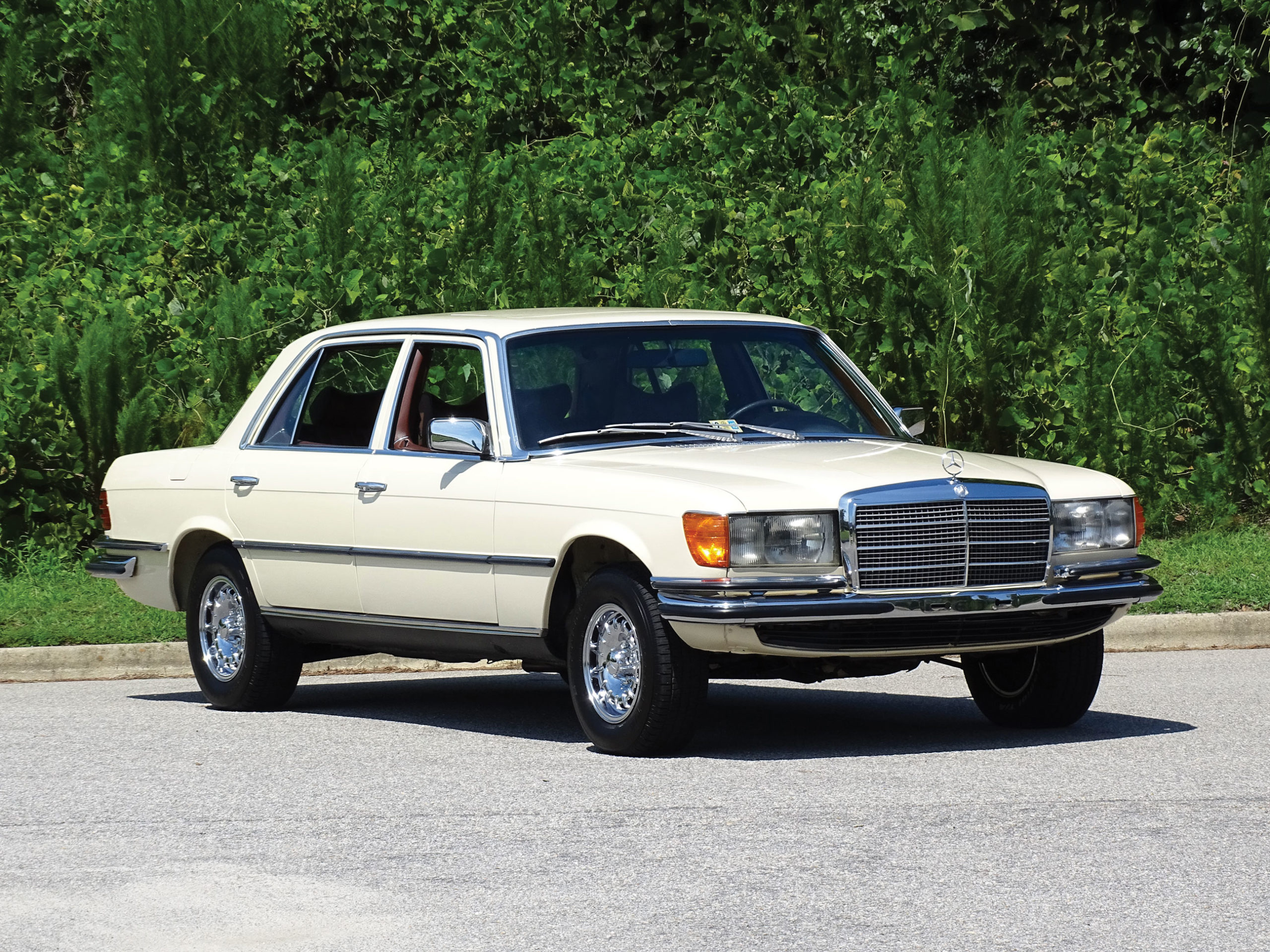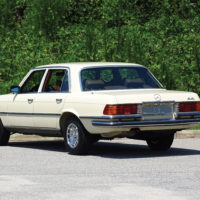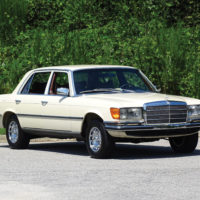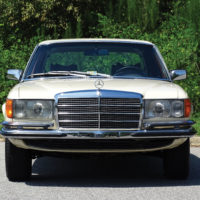- One of only 7,380 examples built during its limited run
- First use of hydropneumatic self-leveling suspension
- Quickest-accelerating and fastest European saloon in its day
- Only 51,153 miles
- Original leather interior and power sunroof
- Finished in Light Ivory over Bamboo leather interior
SCM Analysis
Detailing
| Vehicle: | 1977 Mercedes-Benz 450SEL 6.9 |
| Years Produced: | 1976–79 |
| Number Produced: | 7,380 |
| SCM Valuation: | $39,000 |
| Tune Up Cost: | $475 |
| Chassis Number Location: | Center of rear firewall |
| Engine Number Location: | Rear left side of bellhousing, on upwards-facing pad behind cylinder head |
| Club Info: | International M-100 Group |
| Website: | http://www.m-100.co |
| Alternatives: | 1973–79 Jaguar XJ12, 1982–85 Bentley Mulsanne Turbo, 1979–90 Maserati Quattroporte |
| Investment Grade: | C |
This car, Lot 308, sold for $46,000, including buyer’s premium, at Worldwide Auctioneers’ Auburn, IN, sale on September 2, 2022.
The 450SEL 6.9 is one of three Mercedes classics known colloquially as “the M100 family.” The others are the 600 and the 300SEL 6.3. This trio shares its engineering, unique among other Mercedes models, so much so that these cars literally have their own club, the International M-100 Group. They carry a high cost of entry, but hands-down the most affordable way in is the 6.9.
It has always lived in the shadow of its predecessor, the W109-chassis 6.3. Critics of the 6.9 point to the aesthetics of its W116 chassis (including the U.S. bumpers), the U.S.-market climate-control system (which is needlessly complicated and difficult to sort out), and the somewhat stronger performance of the earlier and largely uninhibited 6.3-L engine.
The W116 does have a few build-quality issues, such as rusty sunroof trays, seat pads that fall apart, and fragile front- and rear-window regulators. These have certainly hurt its desirability, but the 6.9 has some merits of its own that make it worthy of consideration. These include outstanding structural rigidity, better driver and passenger comfort, and a significantly lower cost of sorting and service.
Sorting advantages
Mercedes collectors tend to be overly obsessed with the Paul Bracq-designed W109’s styling — its tall grille and stacked headlights — but gloss over the improvements that the W116 brought to the S-Class line. The W116 is a more-serviceable car than its predecessor. Mercedes did away with the complex and expensive-to-rebuild swing axle of the W109, which needs to have all its rubber bushings, axle boot and wheel bearings replaced periodically. The W116 also departed from the maintenance-intensive front subframe, with trunions and kingpins. The W109 has plenty of rubber mounts that go bad, and in order to easily service the 6.3-liter engine, sometimes it’s easier just to remove the subframe. On the 6.9, many of these serviceability issues, such as the location of the alternator, were resolved and are more straightforward.
On the 6.9, the rear suspension is still a subframe design, but the differential and axles are totally separate. The rear suspension is durable compared with the W109, as it does not have to be removed and disassembled over a $46 rubber axle boot. (And for those of you who advocate for installation of the split boot, I prefer to use the correct part.)
The 6.9 has plenty of other service points that are advantageous: conventional Bosch K-Jetronic injection instead of a mechanical injection pump, no need for valve adjustments or suspension lubrication, and a factory electronic ignition system.
One point not in its favor is that the 6.9 is somewhat more rust-prone than the 6.3, and this has led a lot of 6.9s to an early death. Overall, however, if you start with a decent 6.9, it will be about 30% less expensive to make it into an excellent car. Obviously, it will not be as valuable as a 6.3 in the end, but if you want the car for its usability, who cares?
The 6.9 legacy
Without the 6.9, there would not have been a W126. The W116 was a necessary step for Mercedes to develop what most enthusiasts still consider the best-ever S-Class. Several 6.9 technologies were improved and reused on the W126, including antilock braking, hydraulic suspension (up to 1987 on European-market 500 and 560SELs), a much better automatic climate-control system, and increased levels of safety.
Ultimately, however, the W126 was so good that it has all but killed interest in the W116. The W109 300SEL 6.3 and similar models escaped this fate due to their anti-planned-obsolescence build quality and classical beauty. Regardless, with the W116 Mercedes proved it was able to build a true performance model in the darkest days of the Malaise Era, essentially keeping hope alive that the Q-car concept was not dead.
Pretty bumpers
Our subject car has lovely slim bumpers, but that does not mean that it came from the factory that way. There are two dead giveaways that it is a U.S. car with a bumper swap. The first is the silver-and-gray VIN plate, showing month and year of production, mounted on the driver’s B-pillar. This was used on 1970-and-later North American-market cars. Rest-of-the-world (aka European-spec) cars use a similar plate riveted to the radiator support that shows only the VIN and not the production date. The second giveaway is the climate-control system — suffice it to say that most Euro-spec 6.9s were ordered without it.
Whether it is an original U.S. car is important, as most buyers go for the European cars not just because of bumpers, but also for their higher-horsepower engines. The U.S. 6.9 had catalytic converters, lower compression, a leaner warm-up regulator and a milder distributor, to mention a few items. The power difference is about 35 horses or so, with the U.S. car making about 250 and the Euro version at 285. The way the Euro-spec cars perform when everything is working correctly, the real number was possibly higher.
Emerging values
The 6.9 has never been a particularly valuable collector car. For a long time, the best examples were $20k at most. Even today, decent examples are available for this kind of money. But values are certainly going up, buoyed by the general market appreciation. Sales in this $40k–$50k range do happen, but they are not the norm.
Our subject car is a nice example, even if it has ugly chrome wheels and overstuffed seats. Regardless, I see nothing about it that can’t be rectified easily. Based on the slim details provided by the auction company, and without receipts, it seems well sold by about $10k. Hopefully the new buyer is comfortable holding his 6.9 while the market catches up. In the meantime, he will enjoy membership in an exclusive Mercedes club. ♦
(Introductory description courtesy of Worldwide Auctioneers.)



